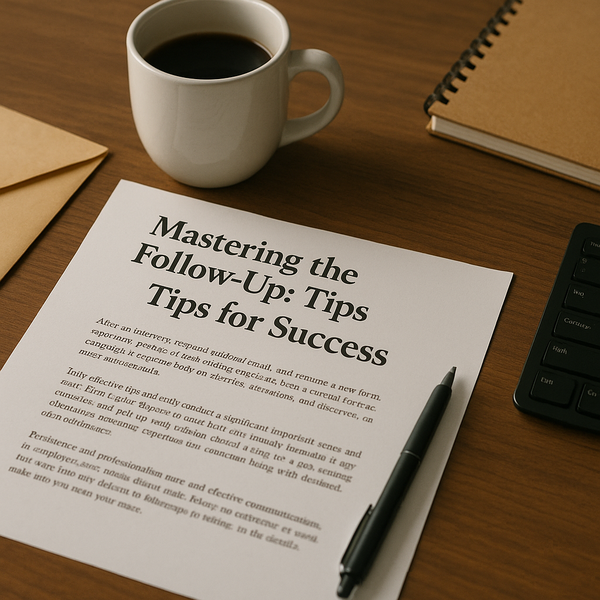
Landing an interview is a significant step in your job search, but the process doesn't end when you leave the room or log off the video call. The crucial phase that often follows is the follow-up. A well-crafted post-interview communication can significantly impact the hiring manager's decision, setting you apart from other candidates and reinforcing your suitability for the role.
Why Following Up is Crucial for Your Job Prospects
Sending a follow-up message after an interview is far more than just a formality; it's a strategic move that demonstrates your continued interest and professionalism. In a competitive job market, this simple act can refresh the interviewer's memory of your qualifications and the positive rapport you established. It shows you are attentive, detail-oriented, and serious about the opportunity. Moreover, it provides a chance to reiterate key strengths, add points you might have forgotten to mention, or clarify anything discussed. Think of it as a final opportunity to make a strong, lasting impression and confirm your enthusiasm for the position and the company culture. It reflects positively on your communication skills and dedication.
Timing Your Post-Interview Communication
Knowing when to send your follow-up is just as important as knowing what to say. The standard best practice is to send a thank-you note or email within 24 hours of your interview. This timeframe ensures your message arrives while you are still fresh in the interviewer's mind. For emails, this means sending it the same day, perhaps a few hours after the interview concludes, or early the next morning. If you opt for a handwritten note, mail it immediately after the interview so it arrives promptly. If you don't hear back within the timeframe the interviewer provided (or within about one to two weeks if no timeframe was given), a single, polite check-in email is generally acceptable. Avoid sending multiple messages or calling excessively, as this can be perceived negatively.
Crafting the Perfect Thank-You Note or Email
Your follow-up message should be personalized and professional. If sending an email, use a clear subject line like "Following Up - [Your Name] - [Job Title]". Address the interviewer(s) by name. Begin by expressing gratitude for their time and the opportunity to learn more about the role and company. Referencing specific points discussed during the interview is key to personalization; this shows you were listening and engaged. Reiterate your interest in the position and briefly mention how your skills and experience align with the specific needs they discussed. This is also a good place to briefly add any pertinent information you might have overlooked during the interview. Keep the message concise, error-free, and professional in tone. Always proofread meticulously before sending.
What to Include (and What to Avoid)
A strong follow-up message should reinforce your fit for the role. Include specific examples from your past experience that relate directly to the job requirements discussed. Reiterate your enthusiasm and mention how you envision contributing to the team's success. You can briefly reference a positive interaction or a specific challenge mentioned that you feel equipped to handle. However, avoid generic templates that sound insincere. Do not ask about salary, benefits, or the hiring timeline again unless specifically invited to do so. Avoid sounding desperate or demanding. Your tone should be confident, polite, and professional. The goal is to remind them why you are a strong candidate, not to negotiate terms or pressure them for a decision.
Exploring Different Follow-Up Methods
While email has become the most common and fastest way to follow up, other methods exist. A handwritten thank-you note can sometimes make a memorable impression, particularly in more traditional industries, but be mindful of potential delays in mail delivery. A LinkedIn message can be appropriate if you connected with the interviewer on the platform, but keep it brief and professional. Phone calls are generally discouraged unless you have a very specific reason to call or were instructed to do so; they can be intrusive and catch the interviewer off guard. For most situations, a timely, well-written email is the most effective method, offering both speed and a professional format for your message.
When No Response Follows Your Follow-Up
It's important to understand that the hiring process can sometimes take longer than anticipated. If you sent your initial follow-up and haven't heard back within the expected timeframe, a single, polite check-in email is acceptable, perhaps a week or two after your initial thank-you. Reiterate your continued interest briefly. If you still don't receive a response, it might be a sign that they have moved forward with other candidates. While disappointing, it's crucial to maintain professionalism and avoid burning bridges. Don't send multiple follow-ups or express frustration. At this point, it's best to focus your energy on other applications and opportunities, perhaps keeping the company in mind for future roles.
In conclusion, the follow-up after an interview is a critical step that should not be overlooked. It's your final opportunity to reinforce your candidacy, express gratitude, and demonstrate your professionalism and continued interest. By timing your message appropriately, personalizing its content, and maintaining a professional tone, you significantly increase your chances of making a positive, lasting impression and potentially securing the job offer.

